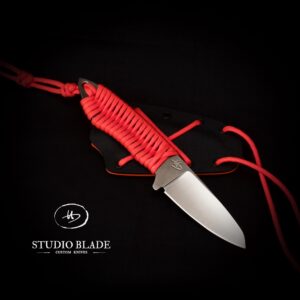
Shop
SANTOKU GOLDEN DRAGON JUMA HANDLE
CHF485.00
Santoku chef knife with a AEB-L stainless steel blade. This steel combines corrosion resistance with superior strength. A unique cutting ability is achieved through superior edge properties. Easy to maintain. The handle materials are very resistant to humidity and easy to clean, these materials are perfect for work in a professional kitchen.
A Santoku is used as a general-purpose kitchen knife originating in Japan. “Santoku” in Japanese means knife “Three Virtues” as this knife is a true all rounder: vegetables, meat, fish, etc… The blade was cryo treated in liquid nitrogen to fully optimise the crystal structure to 62 HRC. This is much harder than regular knives so this knife should be treated as a high precision tool and not as a bone chopper. The blade is 180mm long (demi-chef length) and is made of stainless steel with a very fine grain structure. The handle is a combination of a white G10 liner with Golden Dragon Juma.
- Total Length: 320mm
- Blade length: 180 mm
- Thicknessat the spine 3 mm
- Full flat grind
- Edge: 15DPS sharpening angle
- Steel: AEB-L stainless steel
- Rockwell Hardness: 62 HrC
- Handle material: Golden Dragon Juma white G10 liner
Discover more about AEB-L steel and its exceptional qualities in this detailed article:
Nicht vorrätig
Beschreibung
Santoku chef knife with a AEB-L stainless steel blade. This steel combines corrosion resistance with superior strength. A unique cutting ability is achieved through superior edge properties. Easy to maintain. The handle materials are very resistant to humidity and easy to clean, these materials are perfect for work in a professional kitchen.
A Santoku is used as a general-purpose kitchen knife originating in Japan. “Santoku” in Japanese means knife “Three Virtues” as this knife is a true all rounder: vegetables, meat, fish, etc… The blade was cryo treated in liquid nitrogen to fully optimise the crystal structure to 62 HRC. This is much harder than regular knives so this knife should be treated as a high precision tool and not as a bone chopper. The blade is 180mm long (demi-chef length) and is made of stainless steel with a very fine grain structure. The handle is a combination of a white G10 liner with Golden Dragon Juma.
- Total Length: 320mm
- Blade length: 180 mm
- Thicknessat the spine 3 mm
- Full flat grind
- Edge: 15DPS sharpening angle
- Steel: AEB-L stainless steel
- Rockwell Hardness: 62 HrC
- Handle material: Golden Dragon Juma white G10 liner
Discover more about AEB-L steel and its exceptional qualities in this detailed article:







